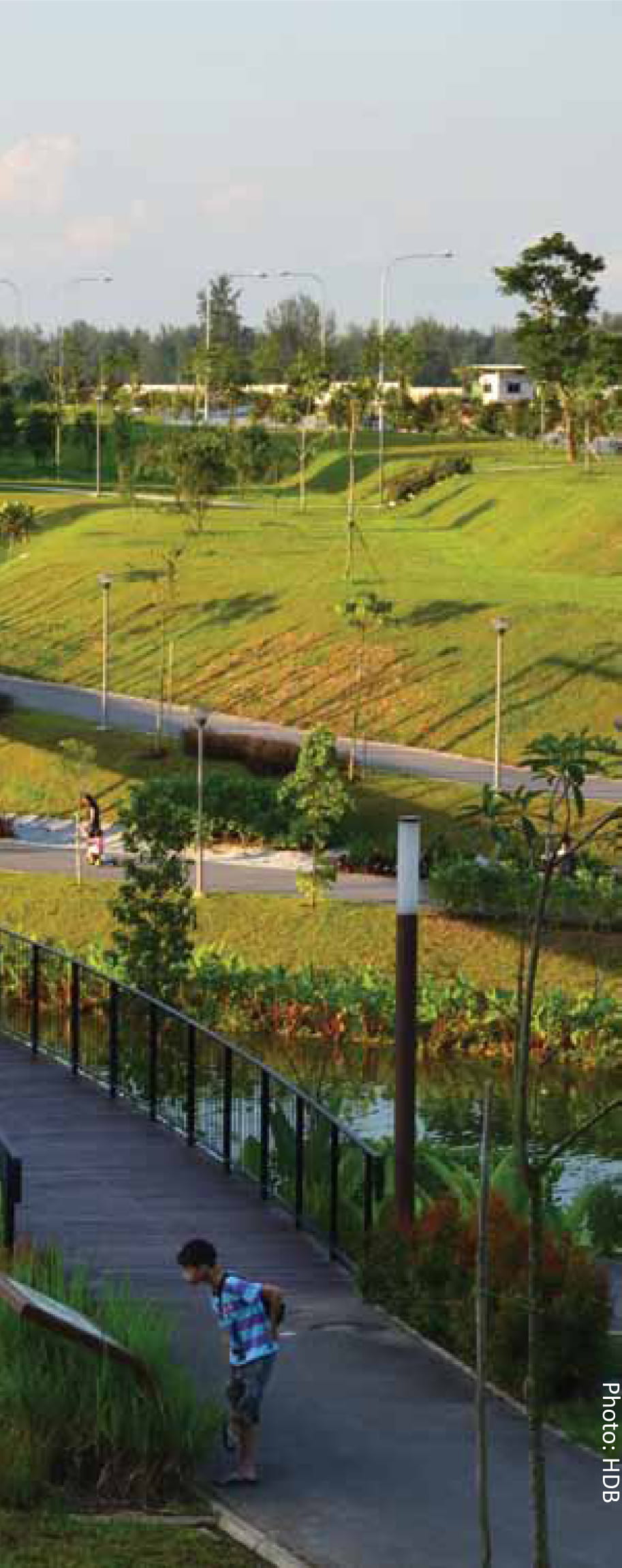Stories > Painting The Town Green
Painting The Town Green
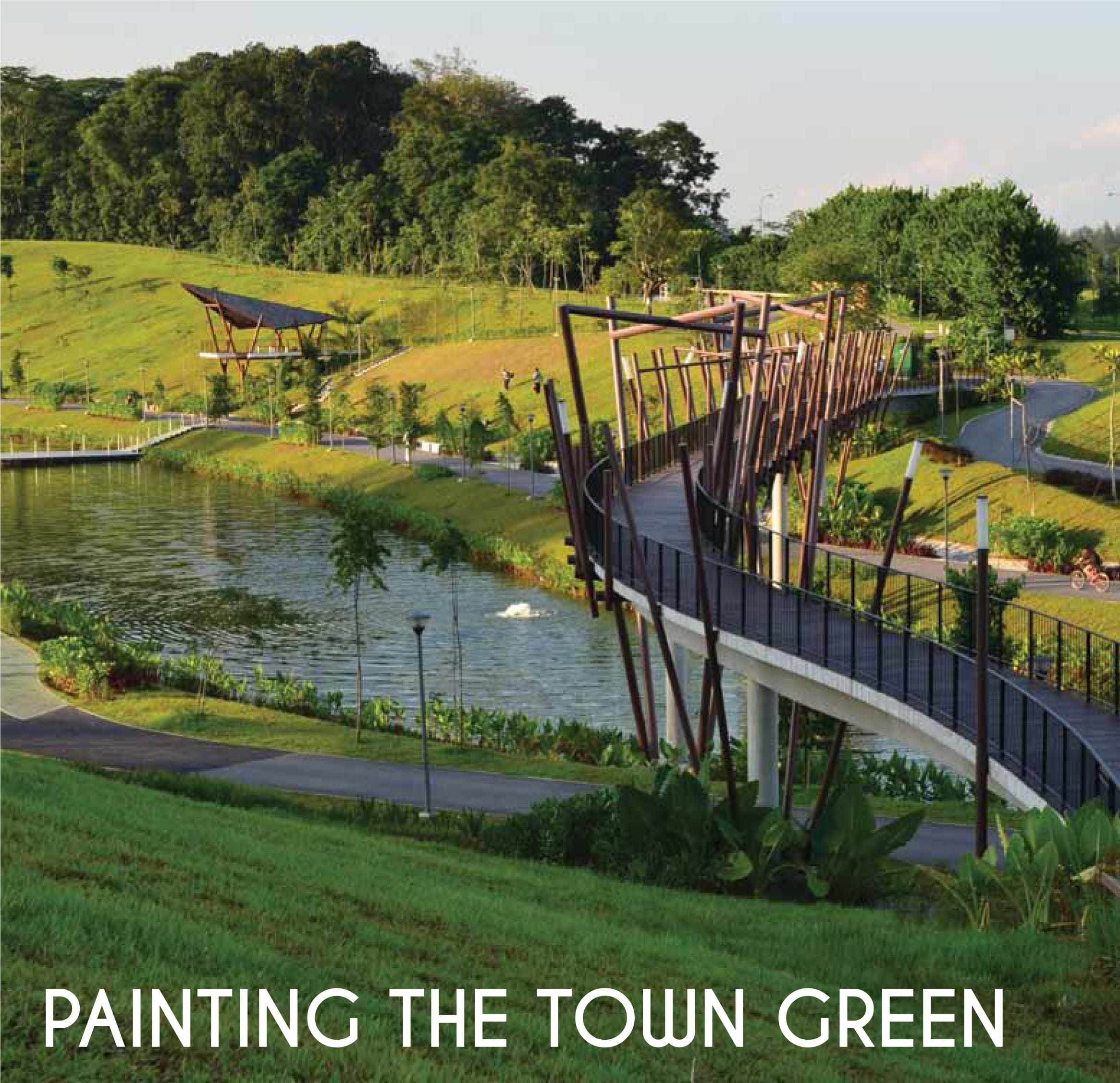
Lush greenery and tranquility at Singapore’s first eco-precinct.
A marshy swampland that once evoked images of the island’s backwaters, Punggol, is enjoying a new lease of life. A national initiative is steering Singapore’s heartlands towards sustainable living, creating a harmonious balance between urbanity and nature.
By Joseph Lim
unggol was synonymous with its famed seafood restaurants in its early days. Old-timers would tell you of its nostalgic coastal charm: a rickety jetty, a sprawl of rustic shophouses along Old Punggol Road, and its laidback vibe. Life then was simple and cheap, and lovebirds would flock there for a picnic by the beach. Back in the ’60s, a family could enjoy a hearty seafood meal for under S$15.
Today, Punggol has been developed into one of Singapore’s best examples of a ‘poster town’ that proactively incorporates sustainable and renewable energy sources into everyday life. This includes the use of solar energy, micro-climatic modeling, a centralised recycling refuse chute, and even non-pollutive agricultural activities.
Cooling and Recycling
A true eco-town must have the right balance of greenery to reduce the urban heat build-up. Punggol has many pockets of shrubs and trees that absorb the heat from buildings as well as ambient carbon dioxide, and turn them into oxygen. Another innovative eco-feature of Punggol is a centralised recycling refuse chute for recyclable materials while getting residents to actively recycle and making their own compost from raw food waste. The hightech estate utilises a specialised computer that capitalises on the wind to cool the surroundings.
This green initiative not only educates the young and old, but also fosters community spirit. In addition, LED lighting is prevalent in all walkways and corridors, powered by renewable solar energy. The solar energy is stored in fuel cells to power devices used by the community.
High-tech, High-rise Living
Treelodge@Punggol is Singapore’s first build-to-order eco-precinct that will see green initiatives being carried out in energy, waste and water management. Located in Punggol New Town, it has the distinction of being the first public housing recipient of the ‘Green Mark’ platinum award. This scheme is a government initiative aimed at steering the construction industry towards green buildings to promote sustainability and heighten awareness on environmental issues.
Residents here could play an important role by spreading the greening message and highlighting the estate’s eco features. The building’s design allows for rainwater to be collected from the roof and filtered. It’s then irrigated to nourish its landscapes or used to wash common corridors. Ng Bing Rong, HDB’s (Housing Development Board) high-rise Project Director explains, “Though it is slightly more costly to construct such eco-features, it is a ‘small price premium’ to pay, but one needs to look at the long-term benefits that protect the environment.”
Treelodge@Punggol saves about two gigawatt hours annually, which is enough to power 400 average four-room households a year. Another prominent eco-feature is how the building uses wind to lower building temperatures and reduce heat build-up inside each unit. The building’s rooftop has more than 2,000 sq metres of solar panels that power lifts, water pumps and lighting in common areas.
Treelodge@Punggol is, in fact, a current ‘model’ to fuel existing research on solar-powered initiatives and perhaps to develop Singapore’s solar industry further.
Solar panels would power up lights in corridors, walkways and landscape features.
Solar energy is captured through these solar panels and used to power corridor lights, lifts and waterpumps.

Another innovative ecofeature of Punggol is a centralised recycling refuse chute for recyclable materials while getting residents to actively promote the concept of recycling ….
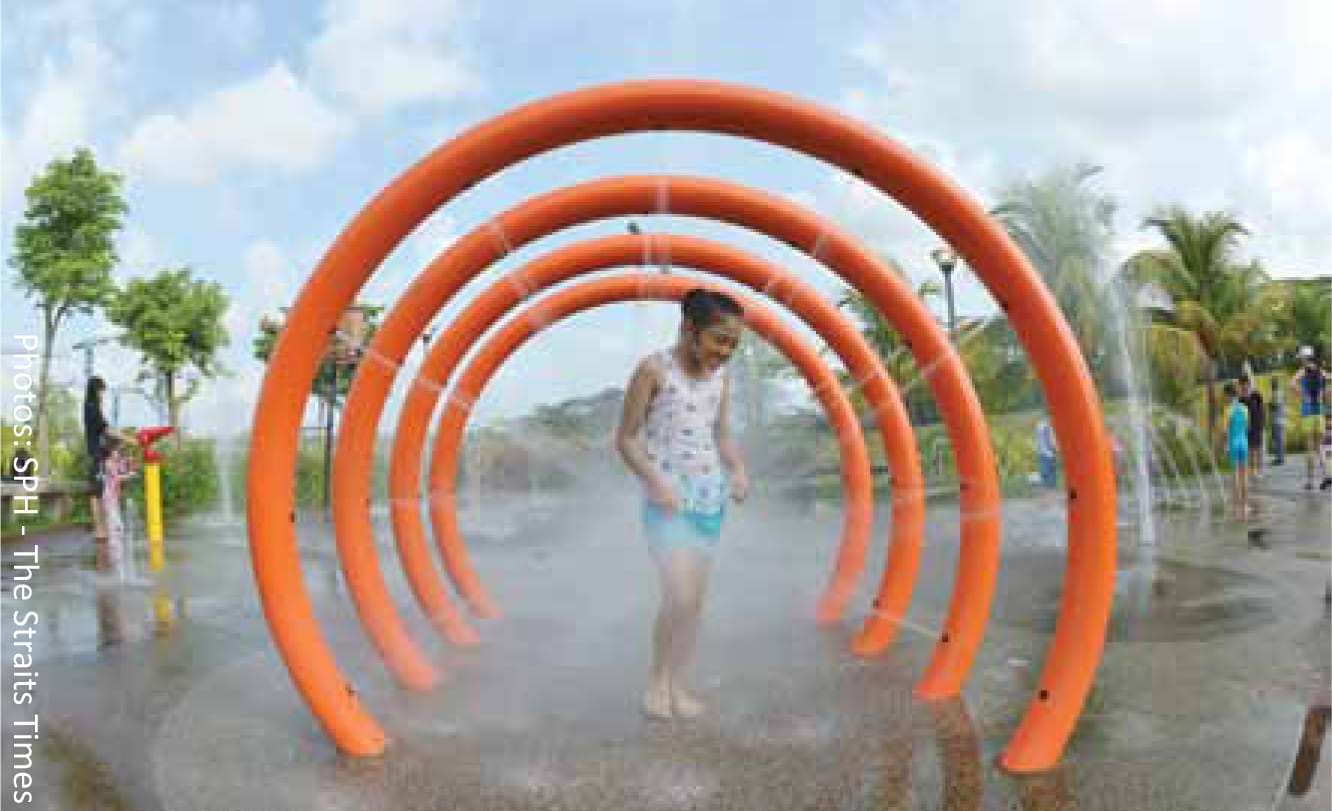
A girl cools down as she walks through sprays of water, at the Water Play Area, Punggol Waterway Park.
Green Living
Some plots of Punggol land were tendered out on short-term leases for agricultural activities such as growing hydroponic vegetables and orchid farms which do not pollute the environment. More than just another new HDB Town, Punggol was slated not only to meet residents’ needs, but to also become Singapore’s first sustainable coastal town. The key is to effectively manage energy, water and waste management.
The goal is to reduce the overall consumption of energy in Punggol by 20% by using solar energy. This underpins the nation’s ‘Sustainable Singapore Blueprint’ which aims to achieve a 35% improvement in energy efficiency by 2030.
Environmentally Aware
In 2011, HDB rolled out a detailed road map to ‘Better Living in HDB Town’ which emphasised the government’s proactive stance towards sustainable and renewable energy sources in the coming decade. Such a town wouldn’t just rely on building an infrastructure for residents; rather, it would also provide an array of eco-features. Eventually, the aim is to get them actively involved in the community spirit of protecting and caring for the environment.
Architects and town planners looked at ‘micro climatic modelling’ to help the new towns capture cool breezes and take advantage of natural ventilation to cut down the reliance on air-conditioning. Solar panels would power up lights in corridors, walkways and landscape features. All these initiatives, part of HDB’s ‘Remaking our Heartlands’ programme, would inevitably transform Punggol, a once sleepy coastal estate into ‘A Waterfront Town of the 21st Century’.
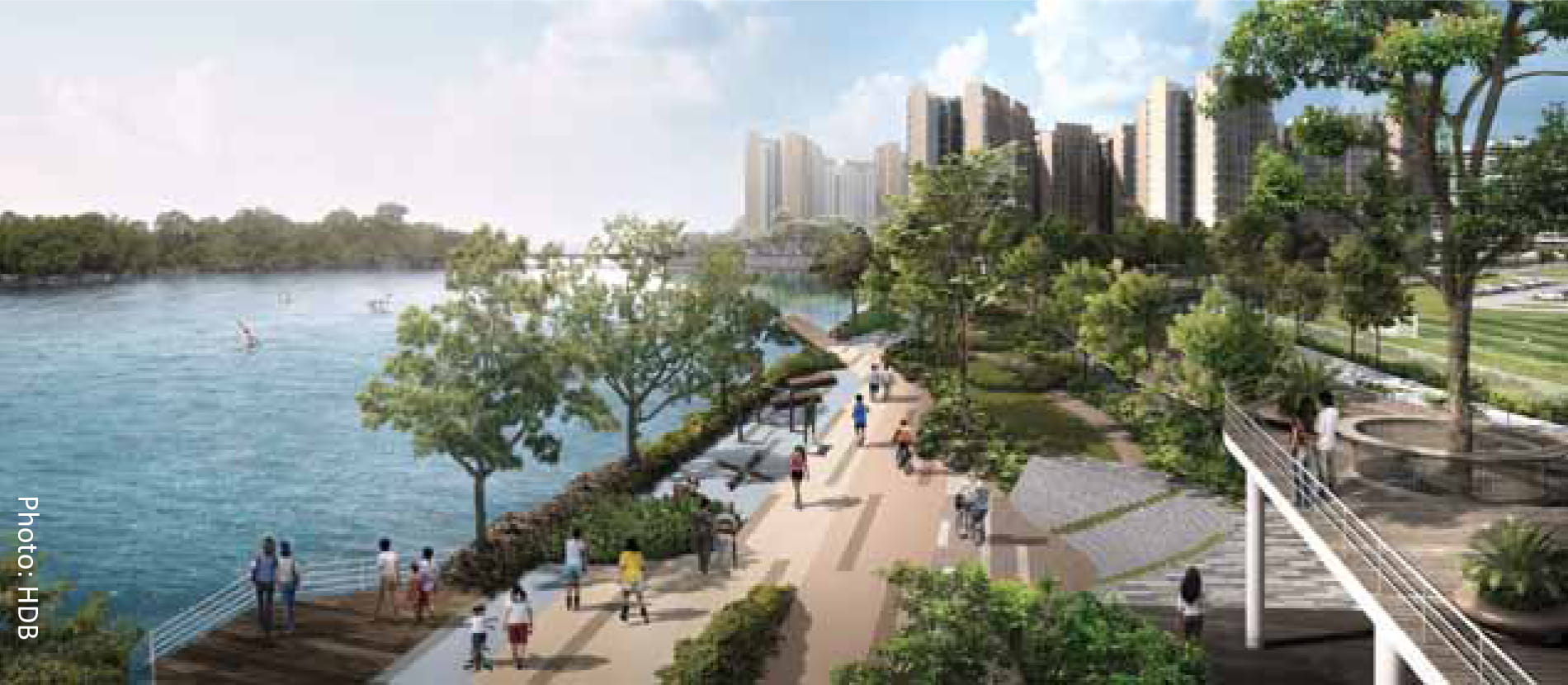
This Waterfront Promenade attracts nature lovers in search of lush greenery and bodies of water in the urban landscape.
Nature, Nature Everywhere
Paying homage to the marshy estuarine seafront of old Punggol, a modern river was constructed. The 4.2km Punggol Waterway links the Punggol and Serangoon reservoirs and allows residents to enjoy waterfront living, and enhances the estate’s sustainability efforts. Aside from the green features, the wide range of flora, fauna and wildlife are sustained because of the river’s existence. Water plants sculpt this living waterway with verdant foliage, beneath which fish and other aquatic life live.
Although man-made, the waterway nevertheless attracts migratory wildlife that adds to the flora and fauna. It sprawls over 12.25 hectares and has four themed areas which contribute to the eco-appeal of the town.
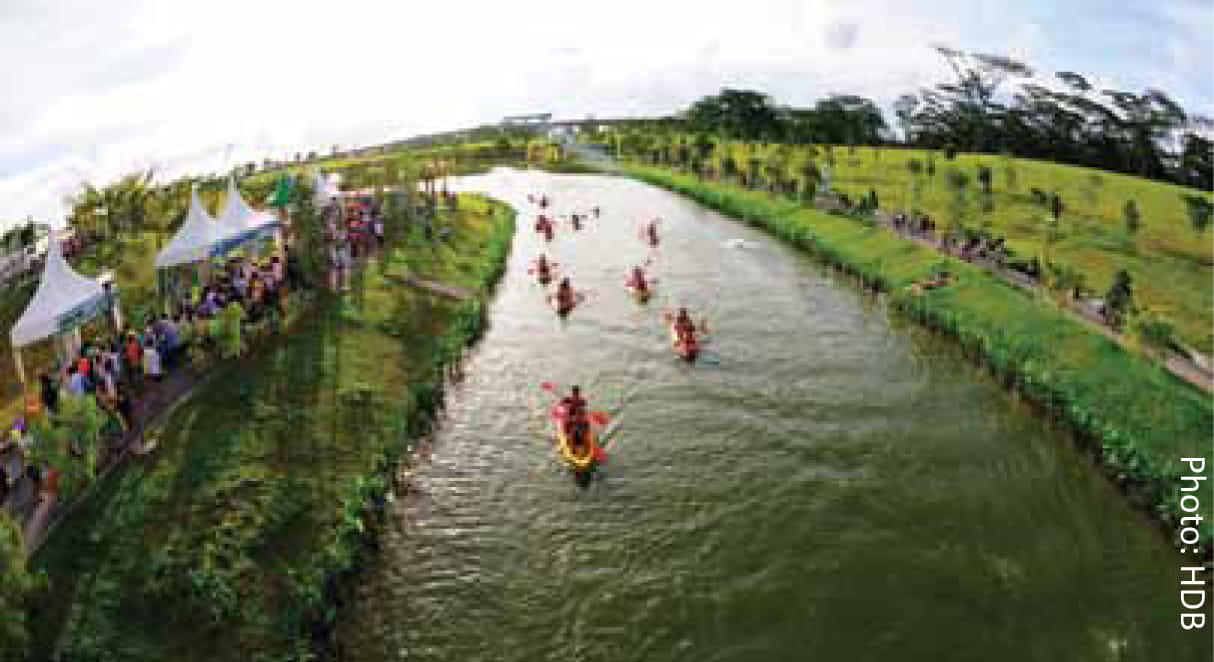
Kayaking along the Punggol River is a popular activity on the weekends.
Connected to Nature
At Nature Cove, one of the themed areas, visitors can enjoy wooded views of the waterway. The entire 8.4km stretch provides a myriad of opportunities for people to reacquaint themselves with nature. At the Heritage Zone, mature trees have been preserved along a stretch of the old Punggol road. The Green Gallery zone features natural terrain for visitors to enjoy.
But Punggol Waterway wasn’t just designed exclusively for Punggol residents. In 2012, plans were announced for four parks to be connected to make up a 26km nature loop. These parks are Sengkang Riverside Park, Punggol Park, Punngol Waterway Park and Punggol Point Park. This lush park connector offers a rich biodiversity and nature-lovers can spot denizens such as herons and kingfishers.
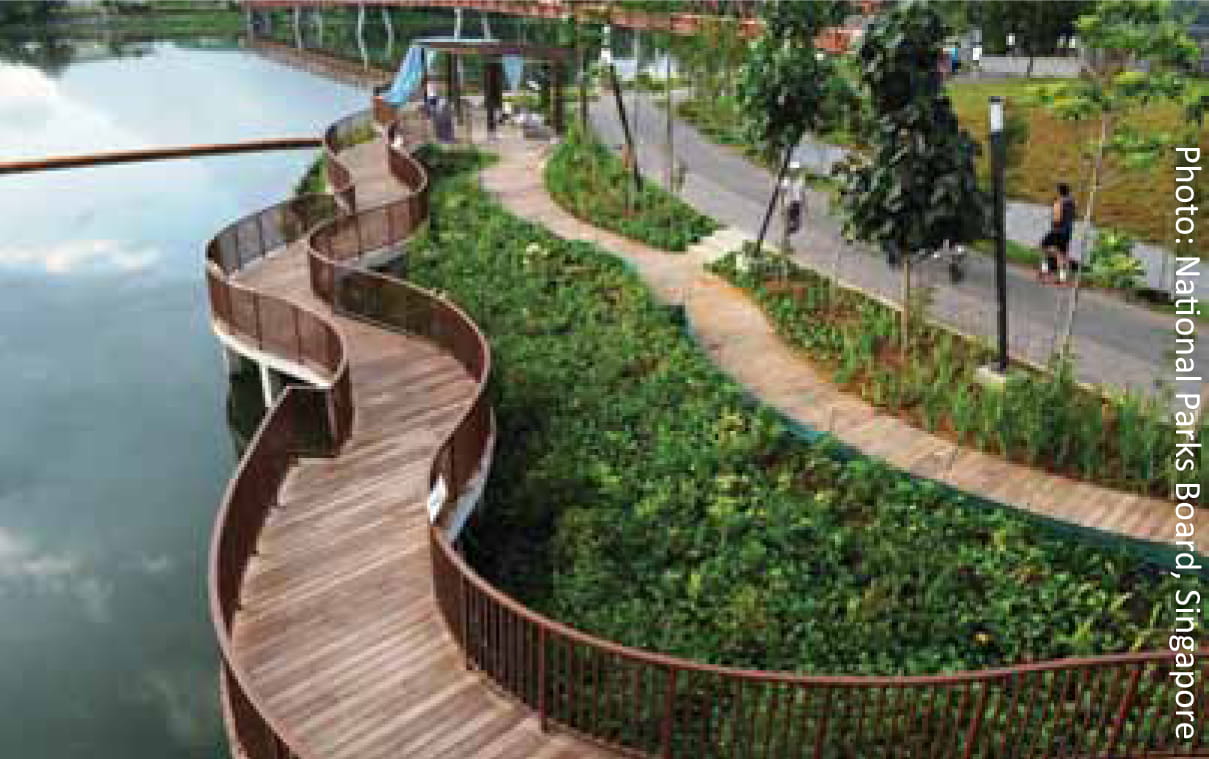
The Punggol Waterway Boardwalk — residents and visitors can soak in the verdant surrounds as they jog, stroll, or exercise their pets.
More Eco-Towns Underway
Punggol’s success will pave the way for more such initiatives in the coming decade as the nation moves towards making Singapore into a sustainable hub in this region.
Tan Yip Kheng, who together with his teenage daughters, head out to the park says, “On weekends, we take long leisurely strolls along the waterway, and this green respite allows my family to bond better. My daughters often get into a conversation with me about what insects, bird or fish they spot.”
A cycling enthusiast, Dillah Jumiah comments, “Every day you see something different. Just cycling along the promenade, you’re immediately drawn to the beauty of this waterway. It makes my cycling sessions even more meaningful.”
Vision of an Eco-Town
Back in 1996, former Prime Minister Goh Chok Tong, in his National Day Rally speech, revealed a plan to develop Punggol into a modern, eco-friendly town known as ‘Punggol 21.’
It was envisioned to be a mixed development commune—residential units complemented by a strong infrastructure and transport amenities like the nearby LRT (Light Rail Transit).
As early as 2005, some residential blocks at Punggol Rural Centre were demolished to make way for high-rise residential apartment blocks. The present-day Sengkang New Town and Punggol New Town have risen where farms once took pride of place.
Though still in the early years of ‘testing’, it is anticipated that these steps will green Punggol as well as bring the community together to better steward natural resources, paving the way for more of such initiatives on the island.
Punggol: History and Heritage
Punggol derived its name from the Malay word ponggol which means to ‘hurl sticks at fruit tree branches to bring the fruit down to the ground’. Archival data reveals that it existed at least 200 years before Sir Stamford Raffles founded Singapore! Delving deeper into history annals, it becomes clear that Punggol was once populated by Teochews who were renowned fishermen.
The early Chinese immigrants who settled in Punggol in the mid-19th century were mainly engaged in hard labour such as plantation work and rubber tapping. Punggol was also rich in vegetable and fruit crops and hawkers would ply their trade at the marketplace at the former ‘eighth mile stone’ located at Punggol Road. It was only in the ’60s that this sleepy seaside town got a jab of modernisation. Basic amenities like piped water, electricity, paved roads and drainage systems were fitted into the kampungs of Punggol. Television was a nascent technology then, and antennas could be seen installed on many kampung rooftops.
As early as the ’70s, the phasing out of poultry and pig farms became inevitable. When the last pig farm shuttered in 1990, the farmers vacated their plots of land and resettled in estates like Toa Payoh and Ang Mo Kio, to pave the way for an eco-town.
Source: HDB

